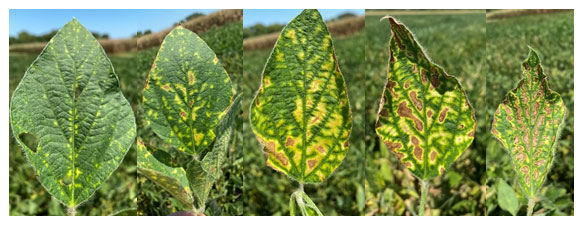Researchers at K-State are in search of soybean fields showing symptoms of Sudden Death Syndrome (SDS) to sample.
What is Sudden Death Syndrome (SDS)?
It is a soil-borne fungal disease caused by Fusarium virguliforme. Infection and colonization begin shortly after planting and the pathogen produces a toxin that causes above-ground symptoms later in season.
What are the symptoms?
Root symptoms include necrosis (death) and above-ground symptoms include interveinal leaf chlorosis (yellow discoloration of the tissue) and necrosis (Figure 1). Under the right environmental conditions, these symptoms appear as early as the start of flowering.

Figure 1. Sudden Death Syndrome foliar symptoms. Photos by Rodrigo Onofre, K-State Research and Extension.
What are the environmental conditions?
SDS is observed more when soybeans are planted in cool, wet soils followed by wet conditions at the beginning of flowering.
What are the management options?
Seed treatment, resistant cultivars, planting date, tillage, and crop rotation.
If you are willing to participate in this study or know of someone willing to participate, please contact us via the emails listed below.
Madison Kessler, Plant Pathology Graduate Student
mkessler@ksu.edu
Rodrigo Onofre, Plant Pathology Extension Specialist
onofre@ksu.edu